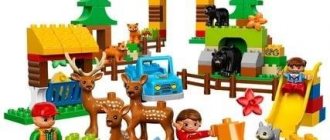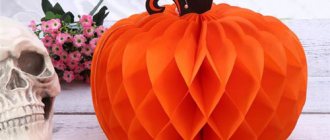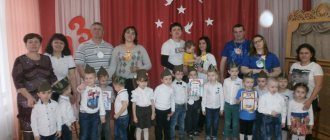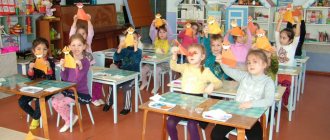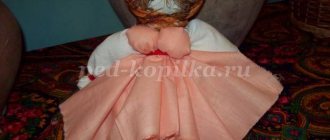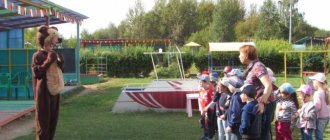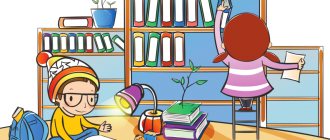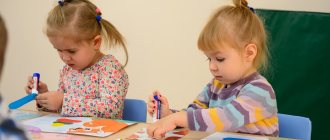Article Outline of the organization of manual labor in the middle group. Author: Kurochkina Elena Evgenievna
Outline of the organization of manual labor in the middle group.
Goal: Consolidating children’s knowledge about work skills in a team by repairing books.
Tasks:
Educational: Continue to involve children in available work activities.
Developmental: Develop attention, observation, mental operations, fine motor skills, aesthetic perception.
Educational: Cultivate a positive attitude towards work, a desire to work together with peers, and treat books with care;
Equipment: books, glue, brushes, scissors, colored paper (cut strips), napkins, oilcloth.
(Children sitting on chairs in a semicircle)
Educator: Guys, today the doll Ira came to visit us, who brought a letter and a torn book. I suggest reading the letter. Do you agree?
Children: Yes.
Educator (reads the letter): Dear children, the Queen of the Book Kingdom writes to you. A girl, Ira, came to visit me; she doesn’t know how to handle books at all, she tore out the pages, painted the cover, but this is not allowed. I know that your group has very friendly and hardworking children. Please teach Ira how to handle books correctly and show how to repair a book.
Sincerely, Queen of the book kingdom.
Guys, can we help Ira? Tell us how to handle books.
Children: Do not throw the book, do not tear out the pages, do not draw in the book, pick it up with clean hands, watch the book only at the table.
Educator: You are right, but how can you help the book?
Children: Glue, hem, put on the cover.
Educator: Well done, I propose to show Ira how we can fix the book. Look at the table. There is equipment for “Book Repair” on the table. Who can tell me what lies there?
Children: Glue, brushes, scissors, colored paper, napkins, oilcloth.
Educator: That's right, guys. Now I will show you how to properly repair a book. (I take a book, and a ready-made ribbon made of colored paper, and glue this ribbon onto the book). Well, guys, it’s as simple as that.
We share 3 people. And we sit down at the tables. Let's distribute responsibilities, who will do what. (Someone will cut out strips, smear and glue the strip, stick it to the book).
Educator: Tell me how to work with scissors?
Children: Do not wave them, pass the scissors rings forward, keep them in a glass.
Educator: That's right, let's get to work.
(I approach each child with an Ira doll, and watch how the children repair books, I draw attention to the fact that working together helps to complete the work faster).
Educator: You see, Ira, how the children coped with the work together, now you know that the book must be handled with care, and if the book accidentally breaks, you can help it. And now we want to give the Queen of the Book Kingdom a joint photo with books. So that she can see how we helped the doll Ira learn about such work as repairing books.
Tell me, did you encounter any difficulties during your work? What? What did you like most? Well done! In gratitude for your help, the queen gives you a magical book of fairy tales.
GCD in the middle group for labor education “Let's help the doll Masha”
GCD in the middle group for labor education “Let's help the doll Masha”
Target:
— Form a positive attitude towards work
.
Tasks:
— Consolidate and improve household labor
:
wash toys, carefully use a cloth and water; bring the job started to completion.
— Promote mastery of a culture of performing activities (observing the three rules of work
: the apron is clean, the workplace is clean, the result of
the work is clean
).
— To develop children’s interest in work
activities of adults, the desire to provide
assistance
, and to take care of the results
of labor
.
Materials: Doll Masha
, dirty toys, basins, sponges, rags, soap dishes, a bucket of water, candy for children.
Move
Educator
: Children, today, while you were sleeping, I was left
alone in the group
.
I sat and typed documents. And suddenly I hear someone talking quietly behind me. I turned around, there was no one, you were sleeping. And then I thought that it was my imagination. I started working further. But the quiet conversation continued. And then I heard and then saw that it was the Masha doll
on the shelf talking with her friends and complaining about us.
She said that children do not like their toys at all. Although they put them back in place, they do not take care of them. Doll Masha
I wanted to invite my friends from a neighboring
group for tea
, but she was uncomfortable because all our dishes were dusty and the food in the store was dirty. I even heard her cry.
Educator
: But it’s true.
We haven’t washed doll dishes and toys for a very long time. Let's help our doll Masha and wash the toys
?
Children: Yes. Let's help
.
Educator
: For work we will need oilcloths for the table. And what else?
Children: aprons, basins, warm water.
Educator
: And that's not enough. What will we wash with?
Children: With a sponge and soap.
Educator
: We’ll dry it on a cloth
Children together with the teacher
They put on aprons and prepare workplaces: they put oilcloths on the tables, put basins, go to dilute the soap solution, and
the teacher
pours warm water and puts towels.
Educator
: But before
we work
, we need to stretch our fingers.
Finger game " Helpers "
One, two, three, four, Rhythmic fist and clap strikes alternately.
We washed the dishes: One palm slides over the other
Teapot, cup, ladle, spoon
And a big ladle. We bend our fingers one at a time for each name of the dish.
We washed the dishes, One palm slides over the other.
We just broke the cup,
The ladle also fell apart,
The teapot's nose is broken, we bend our fingers again.
We broke the spoon a little.
helped mom
. Rhythmic fist and clap strikes alternately.
Educator
: And now
the doll Masha
will give you dirty toys and will watch you
wash
.
Children work independently under the supervision of a teacher
.
Teacher (addresses the doll )
.
Tell Masha
, did you like how we washed the toys?
Doll
: Of course, thank you very much. I hope you won't forget to keep your toys clean?
Children: No, we won't.
Educator
: And now children, while the toys are drying, let’s clear everything from the tables and put things in order after
work
.
That's clean. Masha doesn’t get offended
at us , we
will help her set the table
so that she can treat her friends to tea. And put sweets and fruits on plates.
Well done. I am very pleased that you are such assistants
.
Educator
: Children, do you hear someone knocking?
These are probably guests rushing to our doll
.
(I bring dolls, the children help
seat them at the table along with our
doll Masha
).
Educator
: Oh,
the doll
wants to tell me something.
Doll Masha
: I also want to treat all the children with candy for their kindness and
hard work
.
Children: Thank you!
Abstract of educational activities on labor education for children of the middle group
Abstract of the educational activity “Let's bake cookies” for children of the middle group
Author: Luzina Marina Aleksandrovna Position and place of work: Amur region.
city of Blagoveshchensk, teacher of MOAU pro-gymnasium Topic: “Let’s bake cookies” for children of the middle group
Description: summary of work activities for children of the middle group “Let’s bake cookies.” The main task of this lesson is to teach children to knead dough from certain products and weigh them in different ways: (scales, measuring cup, dividing butter by half). As well as the development of imagination when working with dough. Goal: introduce children to the method of making cookies Objectives: Learn to knead dough from certain products and weigh them in different ways: (scales, measuring cup, divide the product by gender) Development of imagination when working with dough
GCD move
Educator: Hello guys, I want to treat you to cookies. Do you know who makes it? Children: Yes, confectioners Educator: Do you know how they make it Children answer from their experience Educator: And today I want to teach you how to make cookies and play the role of a confectioner. Do you agree? Children: Yes Educator: then let's wash our hands, put on aprons and get to work Children put on aprons, wash their hands Educator: For a serving of cookies you need 200 grams. flour, 200 ml molak, 50 gr. sugar, 1 tsp. cinnamon and 100 gr. oils How do we measure them? Children: using scales Educator: On the table you have a tablespoon, a teaspoon, a measuring cup, scales and a table of measures of different products. How much flour do we need for cookies? Children: 200 grams Educator: How can we measure it? Children: using scales Measured and put in a bowl for dough Educator: How can we measure milk? Children: Using a measuring cup Teacher: How much cinnamon do we need for cookies? Children: 1 teaspoon Educator: Take a teaspoon and add it to the flour Children complete the task Educator: How much sugar and butter do we need? Children: 50 gr. Sahara. Educator: How can we measure these products? Children: Using scales The teacher shows how you can measure sugar using scales. Educator: Do you know that the weight of the product is also usually written on the packaging? Children: Yes Educator: Try to find it on this stick of butter Children are looking for numbers Educator: Who knows these numbers? Great, here's 200 grams. How can we take 100 grams? Children: divide in half. Educator: Correct, we need to divide by half. The teacher, together with the children, cuts off the required amount of food and kneads the dough. The dough needs to be put in the refrigerator for a while. Children at this time are practicing weighing food. Teacher: how much flour is in this bag? Who wants to weigh in? Weighing Educator: Now let's try to measure with a measuring cup. Measuring Educator: Guys, look, our dough has cooled. Now you need to roll it out, do not forget to sprinkle the table with flour so that the dough does not stick. Rolled out Educator: Now take the molds. Masha, Pasha, Katya - what shape is your mold? Educator: Now we’ll have a competition to see who can cut out the most cookies from one piece of dough, leaving as little waste as possible. Children cut out cookies. Educator: How many cookies did you get, Vasya, Zhanna, Kostya? Children: 2, 3, 2 Educator: Well, that's all, our cookies are ready, right, guys? And it can be eaten and consumed Children: No Educator: Why? Children: You still need to bake it. Educator: What can you bake cookies in? Children: In the oven Educator: Can a child set fire to the oven and cook cookies at home? Children: No Teacher: Why? Children: Dangerous Teacher: that’s right, now we’ll put our cookies on a baking sheet, greased with oil, so that the cookies don’t stick. We'll take it to our chefs and they'll bake it for us. What will the cookies be like after they are baked? Children: rosy, beautiful The teacher and the children go to the kitchen and take the cookies
Teacher: while our cookies are being prepared, let’s remember all the stages of work and depict them with symbols 1. Discuss the cookie recipe 2. Select the right products 3. Measure out the right amount 4. Mix the products 5 Kneaded the dough 6. Cooled 7. Sprinkled the table with flour 8. Rolled out the dough 9. Cut out the cookies with molds 10. Coated the baking sheet with butter 11. Placed the cookies on the baking sheet 12. Coated with egg 13. Put the oven to bake 14. Took out the finished cookies 15. Tried it While we are making up stages of preparing cookies, the cook brought them and put them on the table.
Educator: And now guys, I invite you to drink tea with our cookies
We recommend watching:
Summary of educational activities in the middle group of a speech therapist teacher using the method of hippotherapy. Notes of cognitive and research activities in the middle group. Notes of educational activities in the middle group. Wild animals in winter Summary of educational activities for familiarization with the outside world for children of the middle group
Similar articles:
Training children of the younger group in labor activities
Formation of hard work in preschool children
Folklore entertainment in the middle group
Lesson summary on the topic “Mood” in the middle group
Lesson summary for the middle group on the topic: Transport
